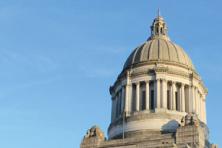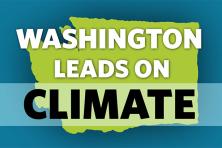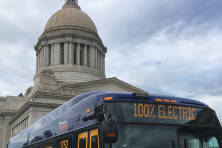There’s an old adage when building a structure: measure twice, cut once. Meaning, if you rush and don’t figure out a fundamental piece of your structure the first time, you could end up with a lot more work, expense, and delay later on.
We are making collective progress in Washington state towards building a better future by cutting global warming pollution—yet there are times when progress feels incredibly slow or even stopped. After a frustrating 2015 session in which the state Legislature completely failed to address our climate crisis, Governor Inslee ordered the Department of Ecology to draft the Clean Air Rule. The rule is a regulatory cap on carbon emissions from our state’s energy, industrial, and transportation sectors under our state’s Clean Air Act. The Department of Ecology is currently soliciting public comments for the updated draft of the rule and will host two in-person hearings this week in Spokane and Olympia.
We firmly believe that done right, Governor Inslee’s rule can be a needed tool toward cleaning our air and accelerating our clean energy economy. It’s a blunt tool, but one that, if made sharp enough, can create some of the needed ways to cut our state’s worst global warming pollution.
Unfortunately, the second draft released last month needs more work to realize its full potential, and to be solid enough to do its job. We’re still concerned that the proposed Clean Air Rule is insufficient to achieve the state’s carbon reduction goals and will set a dangerous precedent for other jurisdictions to follow.
Specifically, Climate Solutions recommends that the Department of Ecology incorporate the following changes to the Clean Air Rule, as detailed in forthcoming joint comments from a number of environmental and clean energy advocates:
Change the architecture of the rule: The current rule design is not the ideal approach to regulating carbon emissions and is not consistent with the best practices of existing carbon markets. Switching to an allowance allocation system—similar to California’s cap & trade program—would reduce the reliance on offsets as the primary compliance method, reduce the administrative burdens on state agencies, and allow the program to link with other markets.
Make sure to measure the science right: The Department of Ecology needs to establish an aggregate cap with science-based limits. The revised draft takes initial steps towards creating an implicit aggregate cap on economy-wide emissions. However, the rule does not go far enough in articulating the overall limit, and the reduction requirements are not consistent with the best available science.
Don’t give double credit for the same amount of work: The Department of Ecology needs to limit the use of offsets in covered sectors to avoid double counting. The current draft rule depends on offset projects as the primary compliance mechanism, but because the rule allows these offsets within sectors already required to reduce, we worry that the Department of of Ecology could double-count each project—once as a result of the initial investment, and again after the project is completed. Many of these would be good projects, but if we hope to achieve the pollution reduction we need, we must make sure that we don’t double-count cuts to pollution.
Fine-tune the reserve account: The Department of Ecology added a new set-aside called a Reserve Account, intended to help businesses grow and expand in Washington while ensuring that pollution keeps coming down. While this was one of the key recommendations of the environmental community, we believe more work needs to be done to properly structure this account. We have a number of recommendations regarding its size, how credits are allocated to the account, and other considerations that we have addressed in our joint comment letter.
Encourage the growth of biofuels to get us off of fossil fuels: Transportation, fueled by gasoline and diesel, is the largest source of carbon pollution in Washington state, making up 46% of our greenhouse gas emissions. Right now, the Rule treats biofuels—a more sustainable alternative to gas and diesel—identically to fossil fuels. Not only is this bad policy, but it puts at risk the growth of a critical climate solution. We recommend that Ecology exempt biomass used for fuels, as is done in California, to make sure we can continue nurturing this as one of the many needed ways to move us beyond oil.
The Department of Ecology needs to sharpen the tool they have right now by reducing loopholes and supporting true climate solutions. Governor Inslee has full authority under the Clean Air Act to address all of these concerns, and he should heed the call to create the strongest possible rule.
The Department of Ecology's completion of this rule will also help the state comply with a landmark decision in the King County Superior Court affirming that children have a constitutional right to clean air, and that the state has an obligation to protect the climate for them. We couldn’t possibly agree more on the need to protect our children’s future and the climate for future generations. While the Department of Ecology appealed that ruling a few weeks ago for technical reasons, we have every reason to believe that they intend to complete the Clean Air Rule this year.
But to be very clear: we need more tools and action than just a completed Clean Air Rule. Governor Inslee pursued this path because the Legislature failed to live up to its responsibility. We need a commitment by legislative leaders on both sides of the aisle to do what’s necessary to transition Washington state to a sustainable, clean economy for all—rapidly enough to solve the climate crisis.




